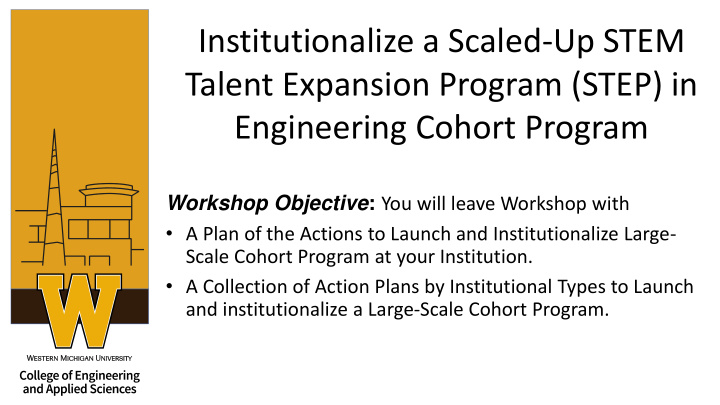



Institutionalize a Scaled-Up STEM Talent Expansion Program (STEP) in Engineering Cohort Program Workshop Objective : You will leave Workshop with • A Plan of the Actions to Launch and Institutionalize Large- Scale Cohort Program at your Institution. • A Collection of Action Plans by Institutional Types to Launch and institutionalize a Large-Scale Cohort Program.
Institutionalize a Scaled-Up STEM Talent Expansion Program (STEP) in Engineering Cohort Program Edmund Tsang, Ph.D. Anetra Grice Emeritus Associate Dean STEP Program Manager College of Engineering and Applied Sciences Western Michigan University wmich.edu/step NSF-STEP Awards (#0336581 and #0969287)
Rationale for Cohorts National Survey of Student Engagement (NSSE) of University of Indiana (http://nsse.indiana.edu/) identifies cohort or learning community as one of six “high impact” practices to enhance student success and retention. Research found placing first-year students in cohort or learning community provides a structure to promote connection among students, faculty and staff, and to deliver student success services. “Environment that supports perceptions of social relatedness improve motivation, thereby positively influencing learning behavior…Participation in cohort programs constitutes such an environment.” Cohorts provide a structure for first-year engineering students to transition to college, and to develop academically and professionally. Cohorts serves as a channel to direct support programs and activities for student success, retention and graduation. Gabeinick, F., MacGregor, J., Matthews, R.S., andh, B.L. (1990). Learning Communities: Creating Connections Among Students, Faculty, and Disciplines , Jossey-Bass, San Francisco: CA. Beachboard, M.R., Beachboard, J.C., Li, W., and Adkison , S.R. (2011). “Cohorts and Relatedness: Self -Determination Theory as an Explanation of How Learning Communities Affect Educational Outcomes,” Research in Higher Education , 52(8), 853-874. Doolenm, T.L. and Biddlecombe , E. (2014). “The Impact of a Cohort Model Learning Community on First -Year Engineering Student Success,” American Journal of Engineering Education , 5(1), 27-40.
Rationale for Cohorts
Rationale for Cohorts Cohorts allowed CEAS to change the narrative during summer orientation
CEAS-STEP Retention/Graduation Rates • STEP IB Results (2010 – present) – avg. 360 students/year 2 nd Year Retention to CEAS above baseline; compares with CSRDE Peers; and 2016 Cohort higher than STEP I (2005-2009) 6-year graduation rate in CEAS trending upward; higher than baseline and CSRDE Peers
CEAS STEP Retention Rates – Algebra II • Admissions criteria to CEAS revised in fall 2012; Algebra II students must have ≥B to continue in CEAS • Created STEP cohorts in fall 2013 for all Algebra II students Year Total # EXEP Return to CEAS Return to WMU 2012 (baseline) 62 25 (40.3%) 40 (64.5%) 2013 Cohort 79 39 (49.4%) 67 (84.8%) 2014 Cohort 90 51 (56.6%) 83 (92.2%) 2015 Cohort 80 42 (52.5%) 57 (71.3%) 2016 Cohort 73 37 (50.7%) 52 (71.2%) Hypothesis: Higher 2 nd -year retention rate versus baseline is correlated to Cohort program • Hypothesis is valid for 2 nd - year retention rate to WMU (a ≤0.05 and DoF = 3; χ 2 =9.250 vs. 7.815) and not valid to CEAS ( χ 2 =6.251 vs . 7.815)
Step 1 INDIVIDUAL Identify 3-5 courses that students in a cohort at your institution would take together in fall semester, and 2-4 courses to take together in spring semester. Examples • Mechanical Engineering Cohort – Calculus I/Precalculus, Engineering Graphics/CAD, General Chemistry I & Lab, Technical Communication/English Composition. • Computer Science Cohort – Calculus I/Precalculus, Computer Science I, Technical Communication/English Composition, General Education
Step 2 GROUP Report and discuss Step 1 with colleagues at your table
Step 3 INDIVIDUAL • Identify the stakeholders in the academic departments that provide instructions of courses in fall semester/spring semesters. • Think about how you are going to build partnership with them
Step 4 GROUP Report and discuss Step 3 with colleagues at your table
Step 5 GROUP Create a communication plan to the stakeholders to gain their support, including a timeline and a process for seat requests and seat “reservations”
Step 6 GROUP Report Step 5 to Workshop
Step 7 INDIVIDUAL Identify the actions to take at your institution for summer orientation with goal of placing students into cohorts CEAS-STEP • Reduce capacity of sections by number of seats reserved for cohorts • Add “department restriction” to section requested on web registration • Have academic advisors to register students • Track usage and report to department; release the reserved seats once summer orientation is complete
CEAS-STEP Cohort Program • Templates are used to facilitate placement of students into STEP cohorts for fall Request to stakeholder departments are made 2 months before class schedules are published • A pool of 30+ CEAS faculty and staff have mentored a cohort
Step 8 GROUP Report and discuss Step 7 with colleagues at your table
Step 9 GROUP Report summer orientation plan to Workshop
Factors Supporting Institutionalization • An active Advisory Board with participation of key institutional decision-makers • Partner with Office of Institutional Research to create a data structure and reporting process • Align program with institutional strategic plan and priorities • Create and use Operations calendar and manuals Report out Step 7 to group • Gain buy-in from faculty and staff • Share resources with other student success programs across campus • Maintain regular communication with campus collaborators • Focus on delivering the best customer-service
Step 10 GROUP Identify the critical factors favorable to institutionalization. Identify the stakeholders involved in institutionalizing the cohort practice. Draft an action plan consisting of a list of tasks to carry out and working relations to nurture and build, to institutionalize the cohort practice.
Step 11 GROUP Report Step 10 to Workshop
Invitation to Collaborate • National Science Foundation - Improving Undergraduate STEM Education: Education and Human Resources (IUSE: EHR) • “[T]his program also encourages replications of research studies at different types of institutions and with different student bodies to produce deeper knowledge about the effectiveness and transferability of findings.”
Comments, Questions & Answers Contact Information Edmund Tsang: edmund.tsang@wmich.edu Anetra Grice: anetra.grice@wmich.edu
Recommend
More recommend